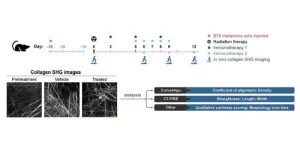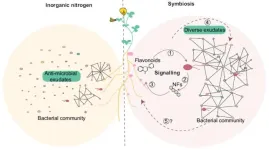(Press-News.org) “The massive use of antibiotics and antimicrobials in people and animals has led to these substances appearing in unexpected environmental samples,” said Irantzu Vergara, researcher in the UPV/EHU’s IBeA group. Drugs that do not end up fully metabolised in the body reach the environment through various routes (such as manure, sewage sludge used as fertilisers, etc.), are leached into the soil and may end up transferring to crops or earthworms, which are at the base of the food chain. “Although no short-term toxicity has been demonstrated in humans, the unintended consumption of antibiotics in the diet can cause problems for allergic individuals; and the effects of long-term exposure remain unknown. However, the biggest problem associated with this contamination is the spread of multi-resistant bacteria; it is difficult to find an effective treatment in the event of infection, which is responsible for 33,000 deaths per year across Europe,” explained Vergara.
To address this problem, the IBeA research group has developed two analytical methods enabling very low concentrations of antimicrobials in vegetables and earthworms to be detected: “Although high drug concentrations can be expected in manure, much lower concentrations are expected after these substances have transferred to plants or earthworms, so sensitive methods are needed to detect them,” said Vergara.
The methods developed by Vergara in the UPV/EHU labs enable a wide range of antimicrobial drugs to be simultaneously determined, as well as various products deriving from their transformation. As the researcher explained, “the drugs can be excreted in their original form or transformed after being metabolised (after undergoing certain changes in the body). What is more, these are very sensitive compounds which, under conditions of temperature, humidity, light, etc., can be very easily degraded and transformed in the environment.”
The methods constitute a significant breakthrough, as “until now there have been no analytical methods to simultaneously study a wide range of antimicrobials in plants and earthworms, and they did not focus on the analysis of transformation products, either. Each family of antibiotics has different physicochemical properties, and it is very important that the same analytical method can be used to analyse all of them. We have also achieved pretty low detection limits, which allow us to detect very low concentrations of these substances in the environment.”
Samples of vegetables taken in different locations across the Basque Autonomous Community
In the case of vegetables, the research group took samples from different locations of the Basque Country, from both organic and non-organic agriculture. “We set out to measure the scale of the antibiotics problem in the Basque Autonomous Community. The analytical studies conducted revealed data on the existence of antimicrobial drugs and their derivatives in vegetables: we found that there is a transfer of both antimicrobials and degradation products between soil and vegetables. In other words, there is a problem of antimicrobial contamination in the Basque Country,” she added.
In the case of earthworms, however, they conducted an experiment under controlled conditions of exposure, in other words “this is a study designed and conducted in the laboratory using earthworms. We wanted to check whether, in the case of contaminated soil, the earthworms that feed on this soil are able to accumulate antimicrobials in their bodies. The study did in fact reveal an accumulation of these antimicrobials in the body, which generate a large variety of previously unreported transformation products.”
Vergara stressed the need to “continue multidisciplinary research along these lines, as this is a problem that is going to affect everyone over the coming decades”. Water treatment plants currently do not have fully effective treatments to remove residual drugs, and this water is often used for irrigation. “As there is such a large, constant input of antimicrobials into the environment, the bacteria are getting used to coexisting with them and generating resistance,” she explained. The researcher warned that “in fact, there are already cases in which there are no effective treatments for people who become infected with multi-resistant bacteria. It is important to drive forward research in order to minimise the problem or to start to look for solutions in the short to medium term”.
Additional information
This study is part of the PhD thesis being written up by Irantzu Vergara in the IBeA research group at the UPV/EHU under the supervision of Ailette Prieto and Maitane Olivares.
Bibliographic reference
I. Vergara-Luis, C.F. Rutkoski, E. Urionabarrenetxea, E.A. Almeida, E. Anakabe, M. Olivares, M. Soto, A. Prieto
Antimicrobials in Eisenia fetida earthworms: A comprehensive study from method development to the assessment of uptake and degradation
Science of The Total Environment
DOI: 10.1016/j.scitotenv.2024.171214
I. Vergara-Luis, M. Jin, J.C. Baez-Millán, B. González-Gaya, I. Ijurco, M. Lacuesta, M. Olivares, A. Prieto
Multitarget and suspect-screening of antimicrobials in vegetables samples: Uptake experiments and identification of transformation products
Food Chemistry
DOI: 10.1016/j.foodchem.2024.138643 END
Developing novel methods to detect antibiotics in vegetables and earthworms
The IBeA research group of the University of the Basque Country (UPV/EHU) has managed to detect very low levels of antimicrobials in vegetables and earthworms
2024-05-23
ELSE PRESS RELEASES FROM THIS DATE:
New biomarkers of response in melanoma immunotherapy
2024-05-23
Collagen, a major component of the extracellular matrix, plays a crucial role in tumor development. During the development of tumors (“tumorigenesis”), collagen fibers become linearized and densely deposited, hindering immune cell infiltration and promoting tumor metastasis. However, quantifying these collagen changes during melanoma progression has been challenging.
In-vivo imaging of collagen
As reported in Biophotonics Discovery, researchers from the Morgridge Institute for Research and University of Wisconsin – Madison recently addressed this challenge by using quantitative imaging to visualize collagen ...
AI headphones let wearer listen to a single person in a crowd, by looking at them just once
2024-05-23
Noise-canceling headphones have gotten very good at creating an auditory blank slate. But allowing certain sounds from a wearer’s environment through the erasure still challenges researchers. The latest edition of Apple’s AirPods Pro, for instance, automatically adjusts sound levels for wearers — sensing when they’re in conversation, for instance — but the user has little control over whom to listen to or when this happens.
A University of Washington team has developed an artificial intelligence system that lets a ...
Electromechanical material doesn’t get ‘clamped’ down
2024-05-23
HOUSTON – (May 23, 2024) – Lighting a gas grill, getting an ultrasound, using an ultrasonic toothbrush ⎯ these actions involve the use of materials that can translate an electric voltage into a change in shape and vice versa.
Known as piezoelectricity, the ability to trade between mechanical stress and electric charge can be harnessed widely in capacitors, actuators, transducers and sensors like accelerometers and gyroscopes for next-generation electronics. However, integrating these materials into miniaturized systems has been difficult ...
Most young women treated for breast cancer can have children, study shows
2024-05-23
In a study of nearly 200 young women who have survived breast cancer, most of those who tried to conceive were able to become pregnant and give birth
This study fills in major gaps from previous studies of fertility among breast cancer survivors
BOSTON – New research by Dana-Farber Cancer Institute investigators has encouraging news for young women who have survived breast cancer and want to have children.
The study, which tracked nearly 200 young women treated for breast cancer, found that the majority of those who tried to conceive during a median of 11 years after treatment were able to become pregnant and give birth to a child.
The findings, ...
SWOG researchers will present key results at ASCO 2024
2024-05-23
Researchers from SWOG Cancer Research Network, a cancer clinical trials group funded by the National Cancer Institute (NCI), part of the National Institutes of Health (NIH), will share results of their work in 30 presentations at the 2024 American Society of Clinical Oncology (ASCO) Annual Meeting, which takes place May 31 – June 4 in Chicago.
The clinical trials reported on in this work are led by SWOG and conducted by the NIH-funded NCI National Clinical Trials Network (NCTN) and the NCI Community Oncology Research ...
MD Anderson Research Highlights: ASCO 2024 Special Edition
2024-05-23
ABSTRACTS: 2018, 2517, 3513, 5504, 6016, 7007, 9515, 12017, LBA8007, LBA9516
CHICAGO ― The University of Texas MD Anderson Cancer Center’s Research Highlights showcases the latest breakthroughs in cancer care, research and prevention. These advances are made possible through seamless collaboration between MD Anderson’s world-leading clinicians and scientists, bringing discoveries from the lab to the clinic and back.
This special edition features presentations by MD Anderson researchers at the 2024 American Society of Clinical Oncology (ASCO) Annual Meeting. In addition to the ...
Dae Hyun Kim, MD, ScD, receives 2024 Harvard Medical School Mentoring Award
2024-05-23
Dae Hyun Kim, MD, ScD is the recipient of a 2024 A. Clifford Barger Excellence in Mentoring Award at Harvard Medical School.
Kim is an associate scientist at the Hinda and Arthur Marcus Institute for Aging Research at Hebrew SeniorLife, an HMS Associate Professor of Medicine, a geriatrician at the Division of Gerontology in the Department of Medicine at Beth Israel Deaconess Medical Center, and a Harvard School of Public Health Instructor in the Department of Epidemiology.
The Excellence in Mentoring Awards were established to recognize the value of quality mentoring ...
A new study reveals key role of plant-bacteria communication for the assembly of a healthy plant microbiome supporting sustainable plant nutrition
2024-05-23
The results in Nature Communications find that symbiotic, nitrogen-fixing bacteria can ensure dominance among soil microbes due to its signalling-based communication with the legume plant host. Researchers discovered that when legumes need nitrogen, they will send out from the roots and into the soil specific molecules that are in turn recognized by the symbiotic bacteria to produce another molecule, the Nod factor which is recognized back by the legume plant. When this mutual recognition was established, the plant will modify the panel of root secreted molecules and by this will affect which soil bacteria can grow in the vicinity ...
Colleen Ryan named Tufts University's Vice Provost for Faculty
2024-05-23
Colleen Ryan, associate vice provost in the Office of the Vice Provost for Faculty & Academic Affairs Indiana University Bloomington (IUB), has been named vice provost for faculty at Tufts University. She will start in the position on July 1.
Ryan currently holds the rank of professor of Italian in the Department of French and Italian at IUB, is an affiliate faculty member in the Department of Gender Studies, and was the director of undergraduate studies for Italian from 2015-2023. Her areas of expertise ...
Scientists map networks regulating gene function in the human brain
2024-05-23
A consortium of researchers has produced the largest and most advanced multidimensional maps of gene regulation networks in the brains of people with and without mental disorders. These maps detail the many regulatory elements that coordinate the brain’s biological pathways and cellular functions. The research, supported the National Institutes of Health (NIH), used postmortem brain tissue from over 2,500 donors to map gene regulation networks across different stages of brain development and multiple ...
LAST 30 PRESS RELEASES:
The impact of family dynamics on eating behaviour – how going home for Christmas can change how you eat
Tracing the quick synthesis of an industrially important catalyst
New software sheds light on cancer’s hidden genetic networks
UT Health San Antonio awarded $3 million in CPRIT grants to bolster cancer research and prevention efforts in South Texas
Third symposium spotlights global challenge of new contaminants in China’s fight against pollution
From straw to soil harmony: International team reveals how biochar supercharges carbon-smart farming
Myeloma: How AI is redrawing the map of cancer care
Manhattan E. Charurat, Ph.D., MHS invested as the Homer and Martha Gudelsky Distinguished Professor in Medicine at the University of Maryland School of Medicine
Insilico Medicine’s Pharma.AI Q4 Winter Launch Recap: Revolutionizing drug discovery with cutting-edge AI innovations, accelerating the path to pharmaceutical superintelligence
Nanoplastics have diet-dependent impacts on digestive system health
Brain neuron death occurs throughout life and increases with age, a natural human protein drug may halt neuron death in Alzheimer’s disease
SPIE and CLP announce the recipients of the 2025 Advanced Photonics Young Innovator Award
Lessons from the Caldor Fire’s Christmas Valley ‘Miracle’
Ant societies rose by trading individual protection for collective power
Research reveals how ancient viral DNA shapes early embryonic development
A molecular gatekeeper that controls protein synthesis
New ‘cloaking device’ concept to shield sensitive tech from magnetic fields
Researchers show impact of mountain building and climate change on alpine biodiversity
Study models the transition from Neanderthals to modern humans in Europe
University of Phoenix College of Doctoral Studies releases white paper on AI-driven skilling to reduce burnout and restore worker autonomy
AIs fail at the game of visual “telephone”
The levers for a sustainable food system
Potential changes in US homelessness by ending federal support for housing first programs
Vulnerability of large language models to prompt injection when providing medical advice
Researchers develop new system for high-energy-density, long-life, multi-electron transfer bromine-based flow batteries
Ending federal support for housing first programs could increase U.S. homelessness by 5% in one year, new JAMA study finds
New research uncovers molecular ‘safety switch’ shielding cancers from immune attack
Bacteria resisting viral infection can still sink carbon to ocean floor
Younger biological age may increase depression risk in older women during COVID-19
Bharat Innovates 2026 National Basecamp Showcases India’s Most Promising Deep-Tech Ventures
[Press-News.org] Developing novel methods to detect antibiotics in vegetables and earthwormsThe IBeA research group of the University of the Basque Country (UPV/EHU) has managed to detect very low levels of antimicrobials in vegetables and earthworms





